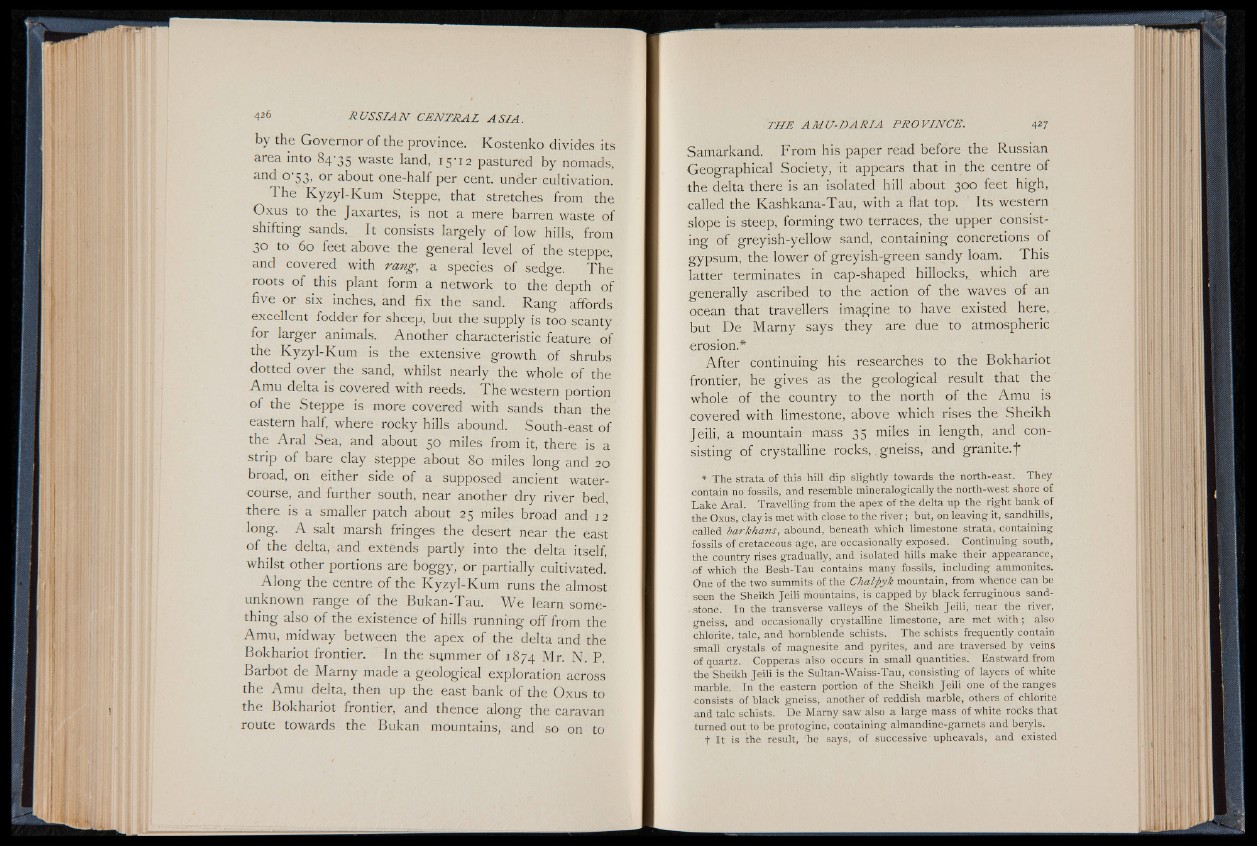
by the Governor of the province. Kostenko divides its
area into 84'35 waste land, 15M2 pastured by nomads,
and o -53, or about one-half per cent, under cultivation.
The Kyzyl-Kum Steppe, that stretches from the
Oxus to the Jaxartes, is not a mere barren waste of
shifting sands. It consists largely of low hills, from
30 to 60 feet above the general level of the steppe,
and covered with rang, a species of sedge. The
roots of this plant form a network to the depth of
five or six inches, and fix the sand. Rang affords
excellent fodder for sheep, but the supply is too scanty
for larger animals. Another characteristic feature of
the Kyzyl-Kum is the extensive growth of shrubs
dotted over the sand, whilst nearly the wbole of the
Amu delta is covered with reeds. The western portion
of the Steppe is more covered with sands than the
eastern half, where rocky hills abound. South-east of
the Aral Sea, and about 50 miles from it, there is a
strip of bare clay steppe about 80 miles long and 20
broad, on either side of a supposed ancient watercourse,
and further south, near another dry river bed,
there is a smaller patch about 2 5 miles broad and 12
long. A salt marsh fringes the desert near the east
of the delta, and extends partly into the delta itself,
whilst other portions are boggy, or partially cultivated.
Along the centre of the Kyzyl-Kum runs the almost
unknown range of the Bukan-Tau. We learn some-
thing also of the existence of hills running off from the
Amu, midway between the apex of the delta and the
Bokhariot frontier. In the symmer of 1874 Mr. N. P.
Barbot de Marny made a geological exploration across
the Amu delta, then up the east bank of the Oxus to
the Bokhariot frontier, and thence along the caravan
route towards the Bukan mountains, and so on to
Samarkand. From his paper read before the Russian
Geographical Society, it appears that in the centre of
the delta there is an isolated hill about 300 feet high,
called the Kashkana-Tau, with a flat top. ' Its western
slope is steep, forming two terraces, the upper consisting
of greyish-yellow sand, containing concretions of
gypsum, the lower of greyish-green sandy loam. This
latter terminates in cap-shaped hillocks, which are
generally ascribed to the action of the waves of an
ocean that travellers imagine to have existed here, .
but De Marny says they are due to atmospheric
erosion.*
After continuing his researches to the Bokhariot
frontier, he gives as the geological result that the
whole of the country to the north of the Amu is
covered with limestone, above which rises the Sheikh
Jeili, a mountain mass 35 miles in length, and consisting
of crystalline rocks,. gneiss, and granite, f
* The strata of this hill dip slightly towards the north-east. They
contain no fossils, and resemble mineralogically the north-west shore of
Lake Aral. Travelling from the apex of the delta up the right bank of
the Oxus, clay is met with close to the river; but, on leaving it, sandhills,
■called harkhans, abound, beneath which limestone strata, containing
fossils of cretaceous age, are occasionally exposed. Continuing south,
the country rises gradually, and isolated hills make their appearance,
o f which the Besh-Tau contains many fossils, including ammonites.
One of the two summits of the Chalj>yk mountain, from whence can be
• seen the Sheikh Jeili mountains, is capped by black ferruginous sandstone.
In the transverse valleys of the Sheikh Jeili, near the river,
gneiss, and occasionally crystalline limestoiie, are met with; also
chlorite, talc, and hornblende schists. The schists frequently contain
small crystals of magnesite and pyrites, and are traversed by veins
of quartz. Copperas also occurs in small quantities. Eastward from
the Sheikh Jeili is the Sultan-Waiss-Tau, consisting of layers of white
marble. In the eastern portion of the Sheikh Jeili one of the ranges
consists of black gneiss, another of reddish marble, others of chlorite
and talc schists. De Marny saw also a large mass of white rocks that
turned out to be protogine, containing almandine-garnets and beryls.
t It is the result, he says, of successive'upheavals, and existed